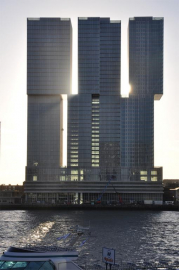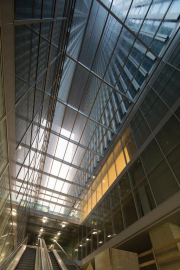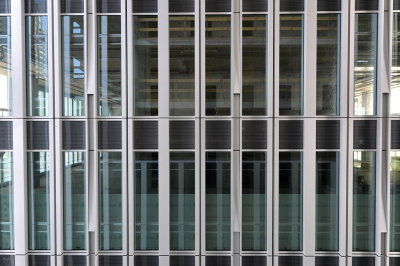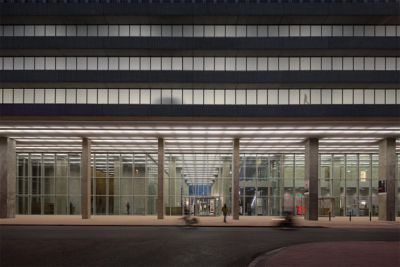De Rotterdam
De Rotterdam is conceived as a vertical city: three interconnected mixed-use towers accommodating offices, apartments, a hotel, conference facilities, shops, restaurants, and cafes. The towers are part of the ongoing redevelopment of Rotterdams harbour district of Wilhelminapier, next to the Erasmus Bridge, and aim to reinstate the urban activity trade, transport, leisure once familiar to the neighbourhood. De Rotterdam is named after one of the ships on the Holland America Line, which departed from Wilhelminapier in decades past, carrying thousands of Europeans emigrating to the US.
The three towers reach 150 m, with a gross floor area of 162,000 m2 on a 3,870 m2 site, making De Rotterdam the largest building in the Netherlands. OMAs architectural concept produces more than sheer size: urban density and diversity both in the program and the form are the guiding principles of the project. The stacked towers are arranged in a subtly irregular cluster that refuses to resolve into a singular form, producing a new composition from every perspective. Similarly, the definition of the building changes according to its multiple uses internally.
The concept phase of the project began in 1997; construction started at the end of 2009, with completion in 2013. The various programs of this urban complex are organized into distinct blocks, providing both clarity and synergy: residents and office workers alike can use the fitness facilities, restaurants, and conference rooms of the hotel. And these private users of the building have contact with the general public on the ground floor, with its waterfront cafes. The lobbies for the offices, hotel, and apartments are located in the plinth a long elevated hall that serves as a general traffic hub for De Rotterdam s wide variety of users. Its façade accommodates a multiplicity of requirements: deep aluminium mullions allow the glazed facades to appear more open or closed depending on the perspective, and its dynamic appearance is determined by the varied cycles of the different programs within.
The building complies with the highest environmental requirements in the Netherlands. It employs a collective power generation system with district heating and co-generation with bio fuel, while water from the adjacent river Maas is used for cooling. Temperature is modulated with geothermal heat exchangers which allow for low temperature heating and high temperature cooling. Additional measures include daylight regulation and motion-controlled lighting in offices, low energy elevators with energy return and water saving taps and reservoirs in offices.
Unlike many urban complexes, De Rotterdams dynamic mix of functions stretches the buildings occupancy cycle to almost 24/7, ensuring a highly efficient utilization of resources. On an average, the building will be used by 4,000 employees, residents, hotel guests and other visitors per day, which accounts for 25% of the total amount of daily users of Wilhelminapier.







OMA.jpg)
OMA.jpg)